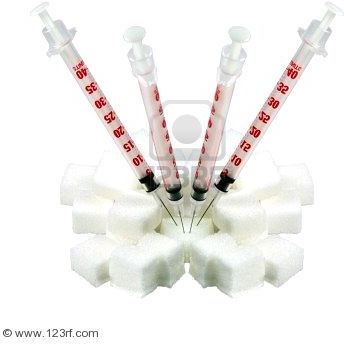
© 123rf.comInsulin syringes stuck into the lump sugar.
Washington - Many food activists and public health researchers are ready to pin a substantial portion of blame for the nation's obesity epidemic on the skyrocketing consumption of high-fructose corn syrup, widely used to sweeten processed foods and beverages in the U.S. since the 1980s. But food and beverage makers are fighting back.
Glucose and fructose are both simple sugars - and equal parts of each is the recipe for table sugar. (High-fructose corn syrup is a bit more intensely sweet because it's made up of 55 percent fructose.) But scientists have long suspected there are differences in the way the human body processes these two forms of carbohydrate. But much of that research has been conducted on animals, leading many to question whether the human body makes any distinction between glucose and fructose.
More research on humans would help. And while a study published online in the March issue of
the journal Diabetes, Obesity and Metabolism raises more questions than it answers, it's a start.
Researchers at Oregon Health and Science University scanned the brains of nine healthy, normal-weight subjects in the minutes after each got an infusion of equal volumes of glucose, of fructose and of saline. The brain scans aimed to capture activity in a relatively small swath of the human brain in and around the hypothalamus, which plays a key but complex role in setting appetite levels and directing production of metabolic hormones.
The researchers, led by Dr. John Purnell, found that "cortical control areas" - broad swaths of gray matter that surrounded the hypothalamus - responded quite differently to the infusion of fructose than they did to glucose. Across the limited regions of the brain they scanned, Purnell and his colleagues saw that glucose significantly raised the level of neural activity for about 20 minutes following the infusion. Fructose had the opposite effect, causing activity in the same areas to drop and stay low for 20 minutes after the infusion. Saline - the control condition in this trial - had no effect either way.
The researchers saw small changes in the same direction within the hypothalamus, where they had expected to see most of the action. But that didn't rise to the level of statistical significance.
What does a different response in "cortical control areas" mean? At this point, said Purnell in a phone interview, it means nothing more than that the two substances did prompt different responses in the brain - that the brain did not respond to them identically. Within some of the "cortical control areas" where differences were seen, lie some important neural real estate, including regions where notions of reward and addiction are processed. As scientists have a closer look in future studies, they should be able to zero in on which specific areas are affected differently by the two forms of sugar, he said.
As those studies look more closely at the hypothalamus, said Purnell, they also may perceive differences not picked up by his team's brain scans.
"This is provocative data: humans respond to these two nutrients differently," said Purnell. But how differently, and differently how - remain to be explored, he added.

Reader Comments
to our Newsletter